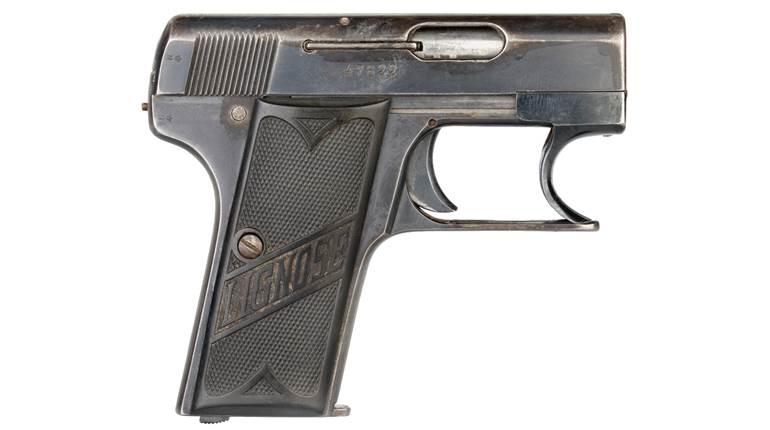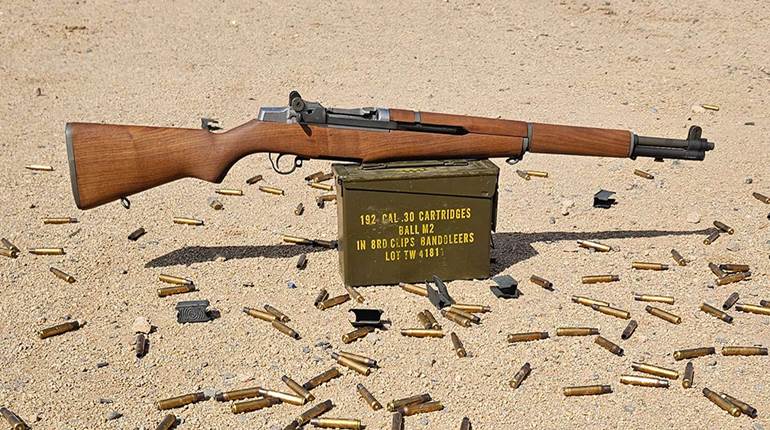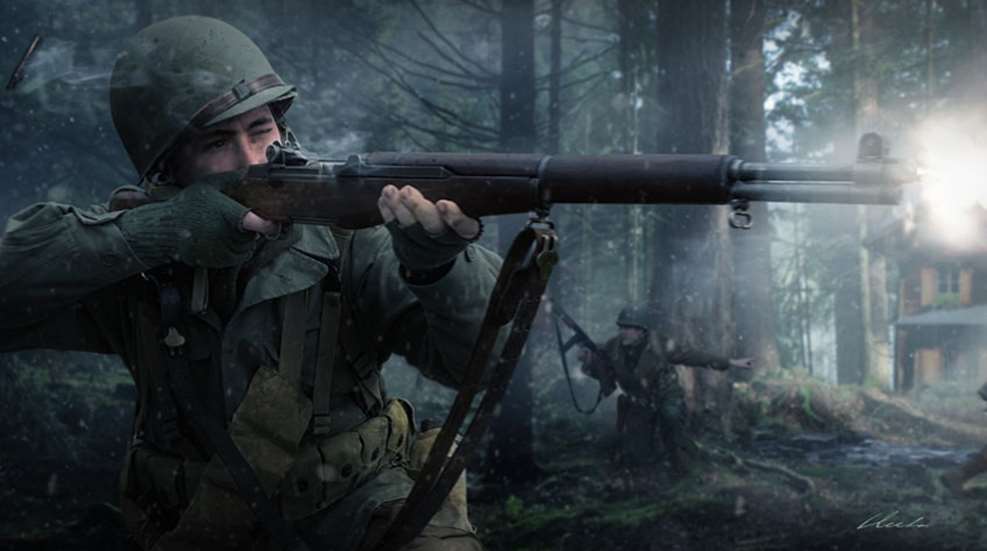
While this illustration depicts Buck Marsh as a 19-year-old rifleman in Germany, we had the opportunity to meet now 95-year Marsh and his friend Clarence Smoyer this year.
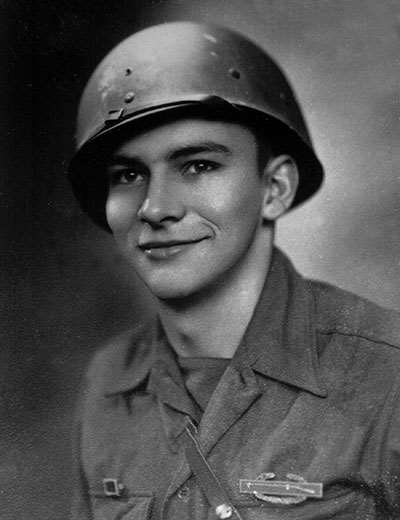
Buck Marsh, a rifleman in Company A, 36th Armored Infantry Regiment, 3rd Armored Division, had his initial close encounter with the enemy during the first week of January 1945. With frigid temperatures and deep snow, it was a miserable situation for the dug-in G.I.s, no matter how well-supplied they were. Yet Marsh would soon learn that his German opponents had it worse. One night while he and his friend, PFC Bob Janicki, walked through the dark to relieve a machine gun post, they passed by two figures walking in the opposite direction. They believed them to be the men of the shift they were supposed to relieve, and paid them little mind. That changed when they arrived at the post and discovered the men they were supposed to relieve were still there.
The two figures were exhausted German deserters who had sought shelter and had marched up to the bunkhouse where Marsh and Janicki had come from and knocked on the door to beg. This caused a bit of excitement for the American occupants, but they allowed them to take shelter inside, under guard. Later that night after his shift, Marsh sat across a table in the bunkhouse from the two Germans. As he dug through a K-ration, he left aside a can of processed cheese, which he didn’t care to eat. One of the Germans motioned at the can, to which Marsh nodded in agreement. Quickly, however, he found himself in a scary situation as the German pulled a wicked-looking Hitler Youth knife from his boot.
As the German held the knife, Marsh’s eyes turned to his M1, sitting just within reach against the wall, loaded with the safety on. He began to lean over and extend his arm toward his rifle, his mind anxious if he would have time to pull it up and disengage the safety before the German was on top of him. But instead of attacking, as Marsh feared, the German used the blade to open the cheese and split it between himself and his comrade. They both smiled deeply and thanked Marsh as they quickly ate every bit of the cheese—they were clearly starving. The German then presented the knife in its scabbard to Marsh, which he still has to this day. He luckily did not have to test how fast he could turn off his M1’s safety.
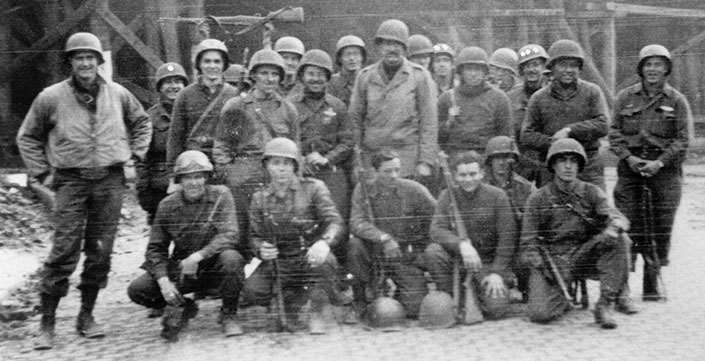
Malcolm “Buck” Marsh, Jr., was a native of Florence, Ala., and attended Tennessee Polytechnic Institute, where he was captain of the tennis team, and he is one of the men featured in bestselling author Adam Makos’ most recent book, Spearhead. Marsh enlisted in the U.S. Army in 1944, and he was assigned as an armored infantryman. In December, the then-22-year-old private first class was sent to the front just as the Battle of the Bulge was coming to an end. Marsh was one of 19 replacements rushed to his company to make up for the losses sustained in pushing back the attempted German offensive. As an armored infantryman, he and the rest of the “Doughs,” as they were nicknamed, would support the tanks of the 3rd Armored Division as they pushed eastward into Germany. Despite the weakened state of German forces at the beginning of 1945, the task of advancing into Germany would be as dangerous as ever.
As a rifleman, Marsh was issued one of the most iconic small arms of World War II, the M1 Garand. The M1 was the first self-loading rifle to be standard-issue for the U.S. Army, replacing the bolt-action Springfield M1903. Adopted in 1936, the M1 was a gas-operated semi-automatic rifle, which used the force of expanding gases near the muzzle acting on a rod to push the bolt back to extract and eject the spent cartridge. A return spring pushed the bolt forward to strip off a cartridge and chamber the round. The operation required no manual manipulation of the bolt, and, thus, allowed for faster follow-up shots. The M1 used an en bloc clip to hold eight .30-’06 Sprg. cartridges in the rifle’s internal magazine. Once the last round was fired, the clip was launched free of the action with an iconic “ping.”
As Marsh recalled, he received an M1 when he joined the regiment in Belgium. He said it looked “brand spanking new” and had likely been made only months previously at either Springfield Armory or Winchester Repeating Arms—he couldn’t remember which. Marsh walked down to a cleared pit with an ordnance officer, where a target was positioned 200 yds. from a bench. He then fired the rifle, made adjustments to the sights, and then set the zero and tightened down the sights with their lock-bar anchor. That M1 would be his companion throughout the war.
Marsh’s first experience in combat came on March 2, 1945, when he and the rest of A Company had split from the tanks and were pushing through a forest near Oberaussem, Germany. This was during the 3rd Armored Division’s push toward the German city of Cologne and the Rhine River. Marsh volunteered for the most dangerous role, that of first scout. As such, he moved just ahead of the rest of his squad, looking for any signs of the enemy. They came up to an opening in the trees where a hunting lodge sat across a narrow bridge spanning a stream. Marsh surveyed the area and noticed a dugout underneath a large tree in front of the lodge, about 150 yds. from him. He then saw a gray German helmet appear over the top of the dugout, its owner looking around for enemy combatants.
The helmet sank back down and immediately thereafter, an MG-42 machine gun opened up from the position with two bursts into the woods. Luckily, it was in the wrong direction and didn’t hit any of the Doughs. The machine gun position was a major threat to the group, who would have to charge straight into its field of fire. Marsh moved up from his cover slowly against a tree and braced his M1 against it, steadying himself. After the bursts, the German gunner’s helmet came back up. Marsh aimed right in the center of the helmet, methodically squeezed through the trigger and fired. His shot connected, and the helmet disappeared back down. He quickly fired off the remaining seven rounds before dropping back down into cover.
After calling in mortar support on the dugout, Marsh and the rest of his company stormed across the bridge and encircled the position, only to find it empty. Marsh took notice of a trail of blood moving through the dugout and followed it toward an entrance to the lodge’s cellar. Bursting inside ready for a fight, Marsh discovered several Germans huddled around something on the ground. As they dispersed, he noticed they were all young and their faces were filled with grief. He then turned his attention to what they were gathered around, and came face to face with the result of his marksmanship.
The soldier was young, nearly the same age as him. He was still alive and moaning despite being shot in the center of his head, clean through. Seeing this unsettled Marsh, and he began crying out for a medic. His friend Janicki took notice of Marsh’s anguish, and pulled him out of the cellar to calm him down and ease his mind about what had happened. Janicki told him that he had to take that shot and that he had saved the lives of the rest of their squad, which would have otherwise charged right into the machine gun. To further distract him, Janicki urged Marsh to accompany him in searching the rest of the lodge. Upstairs they found large cabinets with fine sporting guns inside. Janicki began pulling out ornate hunting guns and urging Marsh to find one to take back for his younger brother.
Marsh picked out a triple-barrel rifle/shotgun combination gun from the case with ornate engraving, and the owner’s animal count tallied up on the right side of the butt with brass tags organized into each kind of animal. The drilling had two 16-ga. shotgun barrels on top of a single 8x57 mm Mauser rifle barrel. There was an integrated trapdoor storage compartment for spare rifle cartridges in the butt, a peep sight tower for aiming the rifle barrel that folded into the grip, dual triggers, dual exposed hammers and a selector for the two different modes. Marsh kept the disassembled drilling tucked away in his half-track, and he would deer hunt with it on many occasions after the war.
As the tanks and armored infantry moved through the suburbs and into the ruined urban areas of Cologne, the situation facing Marsh and the Doughs became more dangerous. Allied bombing had reduced the buildings to rubble and clogged the streets. This made perfect hiding spots for German infantry, snipers and anti-tank teams that lay in wait to fight delaying actions as the Americans pushed toward the city center. It was the Doughs’ job to clear out these defenses. They learned that the enemy they faced ranged from reservists with no real desire to keep fighting to seasoned fanatical troopers determined to fight to the death. Combat in Cologne was all close-quarters—street to street, building to building, room to room. Snipers hidden in the wrecked buildings killed many as the Doughs tried to locate them. Marsh lost several comrades in this way as they moved through the ruined city streets. As they neared the city center, Marsh and other Doughs came upon an open plaza where the railway station stood. While Marsh moved along the edge of the railway platform, a German machine gun opened up on him. As the rounds snapped just behind his head, he ran fast and hard for cover.
Once he reached the end of the platform and was out of sight from the machine gun, Marsh moved into the large waiting hall of the station, alone. The station had large pews for waiting passengers along the ramp, and there were small huts on the other side. As he cautiously moved through the hall, Marsh spotted a pair of German boots sticking up from one of the pews, as if someone was napping in it. After carefully surveying the rest of his surroundings to make sure there were no apparent threats, Marsh quietly moved toward the back pew to investigate. As he got closer, he found a German captain laying in the pew, pretending to be asleep. Marsh hit the back of the pew with his M1 and ordered the German to stand. The officer promptly stood up at more than 6' tall, towering over Marsh who was 5'4". Marsh was surprised when the officer spoke to him in clear English, and said he had been waiting on the Americans, there were no troops in the hut and that he wished to surrender.
As the officer spoke, Marsh cautiously searched him and removed a leather pistol holster from his hip. Inside was a P08 Luger pistol, 1939-dated with an “S/42” code on the toggle; the holster was also dated 1939. This would become one of Marsh’s most prized souvenirs, and he began to carry it along as his new sidearm. Marsh and his comrades would take turns shooting it during their down time at German helmets they set into the road for target practice. He noted that the recoil of the 9 mm Luger was more controllable than the .45 ACP M1911A1 and penetrated the helmets easier. He also stated that it was very useful for clearing rooms and cellars, where the 9-lb., 3½-ft.-long M1 Garand was not the most practical option. Marsh carried this Luger until he overheard rumors that G.I.s found with Lugers by the Germans ended up shot. At this point Marsh found a Walther P38 to use instead. The Luger and its holster, both in good condition, came home with Marsh after the war, and he would shoot it on occasion. He possesses them to this day.
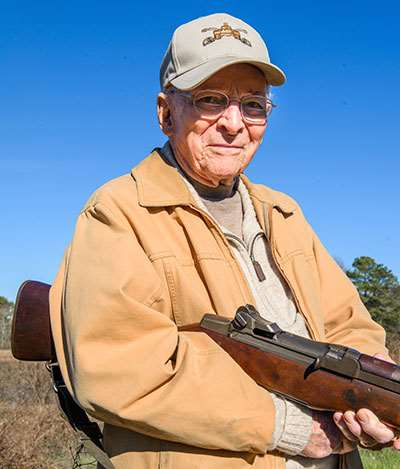
Today, now 95, Marsh and his wife live peacefully just outside of Opelika, Ala., near Auburn University, which he attended after the war. During his time at Auburn, Marsh focused on building construction and joined the Phi Delta Theta fraternity, along with other noteworthy veterans including Eugene Sledge. Afterward, he and his wife moved back to his hometown of Florence, Ala., where he started a successful construction company. He is now happily retired and enjoys a large family of many children, grandchildren and great-grandchildren. Having been an outdoorsman all of his life, Marsh still occasionally enjoys hunting and the shooting sports.
I interviewed Marsh about his wartime experiences and saw many of the souvenirs he brought back with him—including the drilling and the Luger. He wanted to shoot some of the guns, and I learned from author Adam Makos that Marsh had not shot an M1 Garand since the end of the war. With that in mind, I decided to bring my 1944-dated Springfield Armory M1 along. When all the guns were laid out, I snuck my M1 into the mix to see how he would react. He immediately noticed the M1, pointing to it and exclaiming “I know that one, that’s an M1—I want to shoot that!” He picked up the M1 and looked it over, his eyes clearly remembering the last time he had handled his 74 years ago. Marsh noted that it was heavier than he remembered, but confidently tucked it up under his right arm. I handed him a clip, which he deftly loaded into the rifle. He excitedly walked to the firing line with it and fired off a round from the hip saying with a laugh, “It kicks a little more than I remember!” His grandson asked why he was shooting from the hip, to which Marsh replied, “We learned to shoot from the hip; you don’t have time to aim when you’re running to cover and getting shot at.” It was clear that the memories of running through the Cologne streets were still very fresh in his mind. Despite his age and the gap in time since he last used the M1, he handled it as if the past seven decades had never happened. Afterward, he walked around with it confidently tucked under his arm, clearly a rifleman still. His story is just one of those portrayed in Spearhead, just as he and the others there, like his friend tank gunner Clarence Smoyer, recall.
The stories of these heroic men, a generation whose trial by fire came when they were just out of their teens, are tales of self-sacrifice and heroism that we must always cherish and never forget.

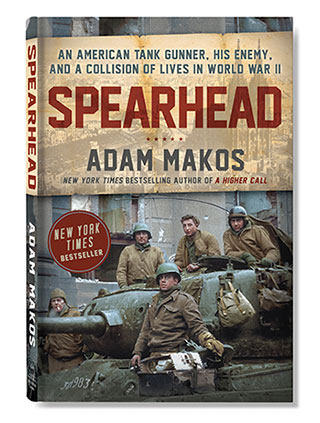 Spearhead
Spearhead
In author Adam Makos’ latest non-fiction bestseller Spearhead, we are introduced to several American and German perspectives of the Allied armored push into Nazi Germany during the final months of World War II, from late 1944 to early 1945. The story begins with, and largely revolves around, the experiences of a young tank gunner, Clarence Smoyer, from the time he was in Sherman tanks during the liberation of France through his time at the controls of the most powerful American tank to fight in Europe, the M26 Pershing.
The book portrays the hardships and terrors that American tankers like Smoyer faced in fighting the Germans with their capable anti-tank guns and fearsome armor. The U.S. Sherman tanks found themselves outgunned against German tanks like the Panther and the Tiger, which their own cannons struggled to deal with. Just as American forces were preparing for the final push into Germany, with its superior armor and firepower to the Shermans, the M26 Pershing entered the scene, America’s answer to the problem. Only 20 M26s would make it into the combat zone before the end of the war, but they would still prove their worth in leading the armored pushes into German territory. When Smoyer became the gunner of his Pershing “Eagle 7,” he and his crew would be the spearhead at the front of every attack.
This would culminate in the Battle of Cologne, where Eagle 7 took on and defeated a German Panther in a close-quarters duel in front of the Cologne Cathedral. The event became famous as it was captured on film up close by combat cameraman James Bates. Tankers are not the only focus, however, one of the perspectives portrayed in the book is that of Sgt. Malcolm “Buck” Marsh, Jr., and his experience as one of the “Fighting Doughs” of the U.S. armored infantry moving up alongside Smoyer and the tanks. Well-written and fast-paced, Spearhead is the story of a band of brothers from the 3rd Armored, and is highly recommended. It is available at booksellers everywhere, including amazon.com. For autographed copies, visit valorstudios.com.












